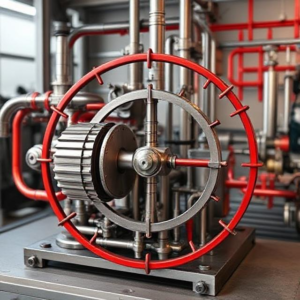Engines and Efficiency: Heat Engines, Carnot Cycle, and Efficiency
Engines are machines that convert energy from one form to another, often turning heat energy into useful work (like moving a car or generating electricity). To understand how engines work and how we can make them efficient, we need to dive into the basics of heat engines, the Carnot cycle, and the efficiency of engines.

1. What is a Heat Engine?
A heat engine is a device that converts heat energy (thermal energy) into mechanical energy or work. The idea is simple: take in energy from a hot source, use it to do work, and then release the leftover energy to a cooler source.
For example:
- Internal combustion engines in cars burn fuel (like gasoline) to produce heat. The heat turns the engine’s parts (like pistons) to do work, making the car move.
- Steam engines used in old trains burn coal to heat water, creating steam. The steam pushes a piston or turbine to generate mechanical work.
How Does a Heat Engine Work?
A heat engine operates in a cyclical process:
- Heat Intake: The engine absorbs heat from a high-temperature source (like burning fuel).
- Work: The absorbed heat is converted into work (moving pistons, turbines, etc.).
- Heat Rejection: The engine then releases the leftover heat to a low-temperature sink (like the exhaust or water).
In simple terms, a heat engine takes in heat, turns some of it into useful work, and gets rid of the rest. The efficiency of the engine depends on how much heat is turned into work and how much is wasted.
2. What is the Carnot Cycle?
The Carnot cycle is a theoretical, idealized process that describes the most efficient heat engine possible. It sets an upper limit on the efficiency of any engine operating between two temperatures.
The Carnot cycle is made up of four stages, which occur in two phases: heat absorption and heat rejection. Here’s how it works:
The Four Stages of the Carnot Cycle:
- Isothermal Expansion (Heat Absorption):
- The gas inside the engine is in contact with a hot reservoir (a source at high temperature).
- The gas absorbs heat from the hot source and expands.
- As it expands, it does work (e.g., pushing a piston).
- Adiabatic Expansion:
- After absorbing heat, the gas continues to expand, but no heat is exchanged with the surroundings.
- The temperature of the gas drops as it expands, and the gas continues to do work on the surroundings.
- Isothermal Compression (Heat Rejection):
- The gas is now in contact with a cold reservoir (a sink at low temperature).
- The gas is compressed, and as it does, it releases heat to the cold reservoir.
- The temperature stays constant during compression because heat is being released.
- Adiabatic Compression:
- The gas is further compressed, and again, no heat is exchanged.
- The gas’s temperature increases as it’s compressed.
In the Carnot cycle, the engine does work during the expansion stages (when the gas is expanding), and the remaining heat is rejected during the compression stages (when the gas is compressed).
3. Efficiency of Engines
The efficiency of an engine is a measure of how well it converts heat into useful work. It’s usually expressed as a percentage. The formula for efficiency (
) is:
In Other Words:
- The input heat is the energy you get from burning fuel (or another heat source).
- The output work is the useful energy the engine provides (such as moving a car or generating electricity).
- The rest of the heat is wasted (released into the environment), and this is the key to improving engine efficiency.
The Carnot Efficiency Formula:
For any engine, the maximum efficiency is given by the Carnot efficiency. This is the efficiency of an ideal engine operating between two temperatures:
Where:
is the temperature of the cold reservoir (in Kelvin).
is the temperature of the hot reservoir (in Kelvin).
Understanding the Carnot Efficiency Formula:
- High Temperature: The higher the temperature of the hot reservoir (
), the higher the efficiency. In simple terms, the hotter the heat source, the more energy can be converted into work.
- Low Temperature: The lower the temperature of the cold reservoir (
), the higher the efficiency. If the sink is cooler, less energy is wasted.
Example:
If you have a heat engine operating between a hot reservoir at 600 K and a cold reservoir at 300 K, the maximum efficiency (Carnot efficiency) would be:
This means that, in the best-case scenario, only 50% of the heat energy can be converted into work, and the rest is wasted as heat.
4. Real Engines vs. Carnot Cycle
While the Carnot cycle represents the most efficient heat engine, real engines are not as efficient due to several reasons:
- Friction: In real engines, friction between moving parts causes energy loss as heat.
- Imperfect Materials: Materials used in engines (like metals) cannot always withstand the high temperatures required for maximum efficiency.
- Heat Loss: In any real engine, not all the heat can be captured or converted to work, and some of it is inevitably lost to the environment.
Efficiency of Common Engines:
- Internal combustion engines (like those in cars) typically have an efficiency of around 20-30%, meaning most of the energy from fuel is lost as heat.
- Electric motors are much more efficient, often around 80-90%, because they don’t rely on heat to do work.
- Steam engines can have efficiencies of about 30-40%, depending on their design and the temperatures they operate at.
Key Points to Remember:
- A heat engine converts heat energy into useful work.
- The Carnot cycle represents the most efficient, ideal heat engine and sets the upper limit for efficiency.
- The efficiency of any heat engine depends on the temperature difference between the hot and cold reservoirs.
- Real engines are less efficient due to factors like friction, heat loss, and imperfect materials.
In Summary:
- Heat engines take in heat, convert part of it into useful work, and release the rest as waste heat.
- The Carnot cycle is the idealized process that shows the maximum efficiency of any heat engine.
- Efficiency measures how well an engine converts heat into work. The Carnot formula tells us that the best possible efficiency depends on the temperatures of the heat source and the heat sink.











